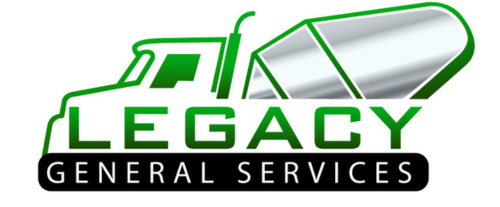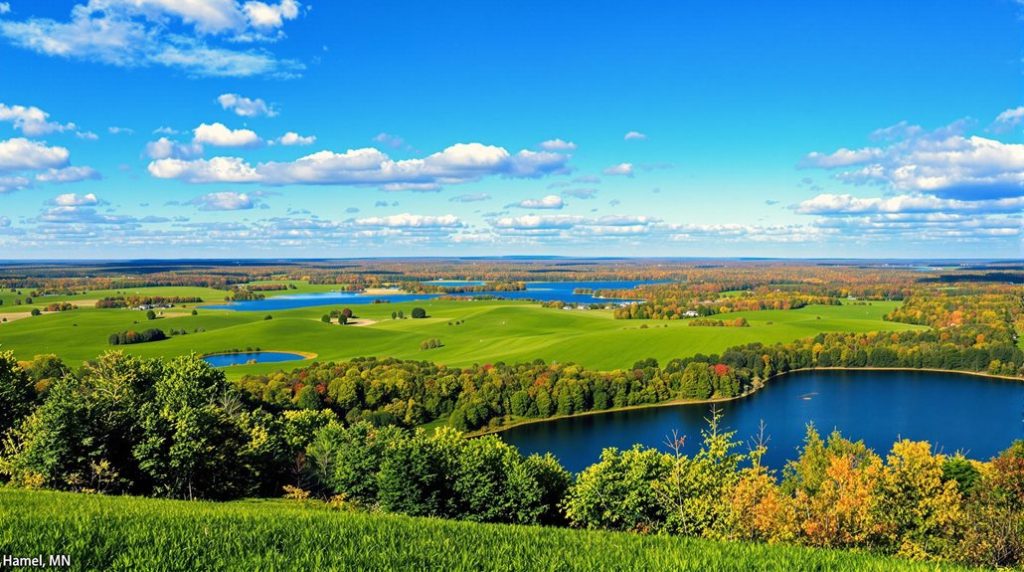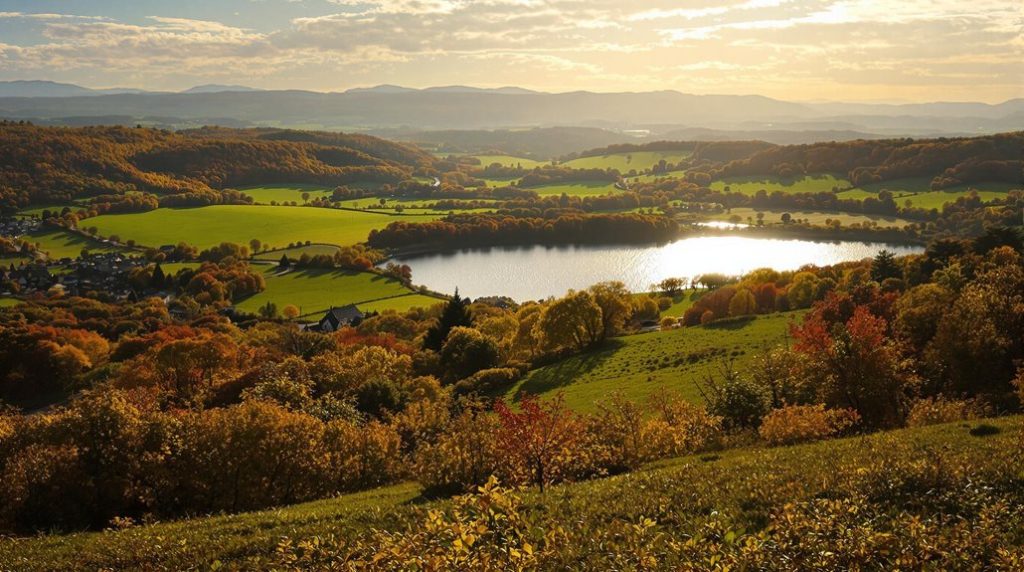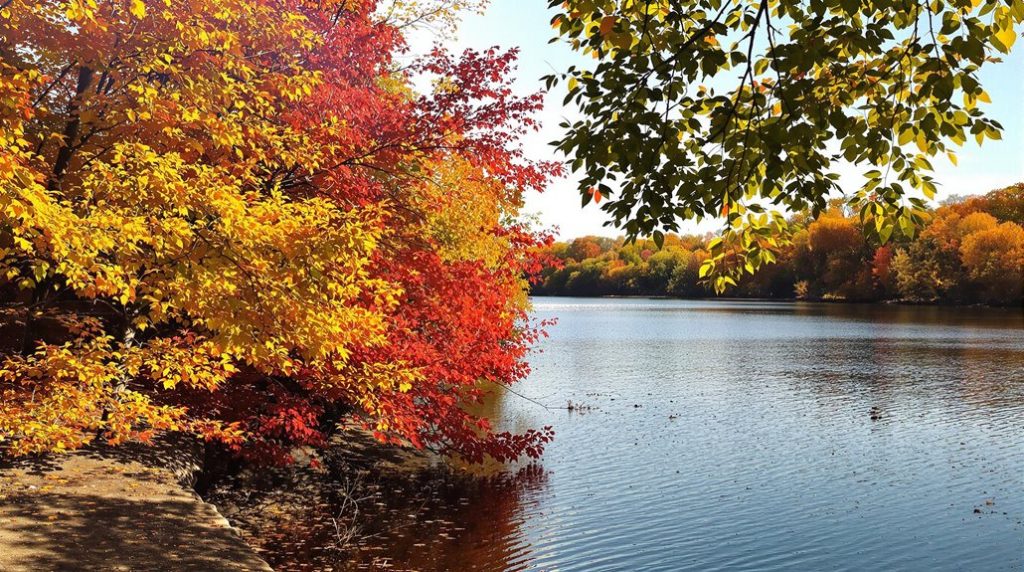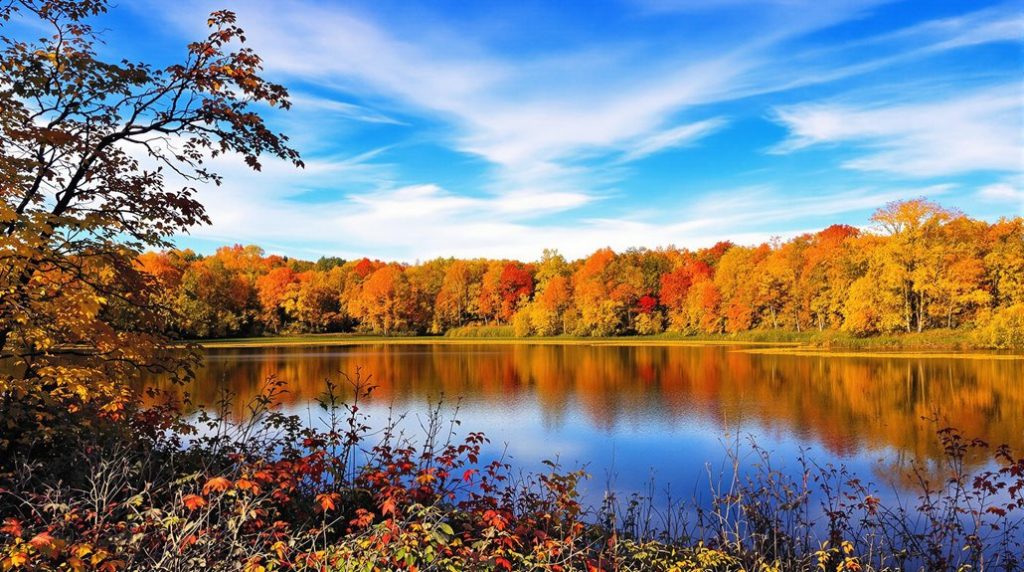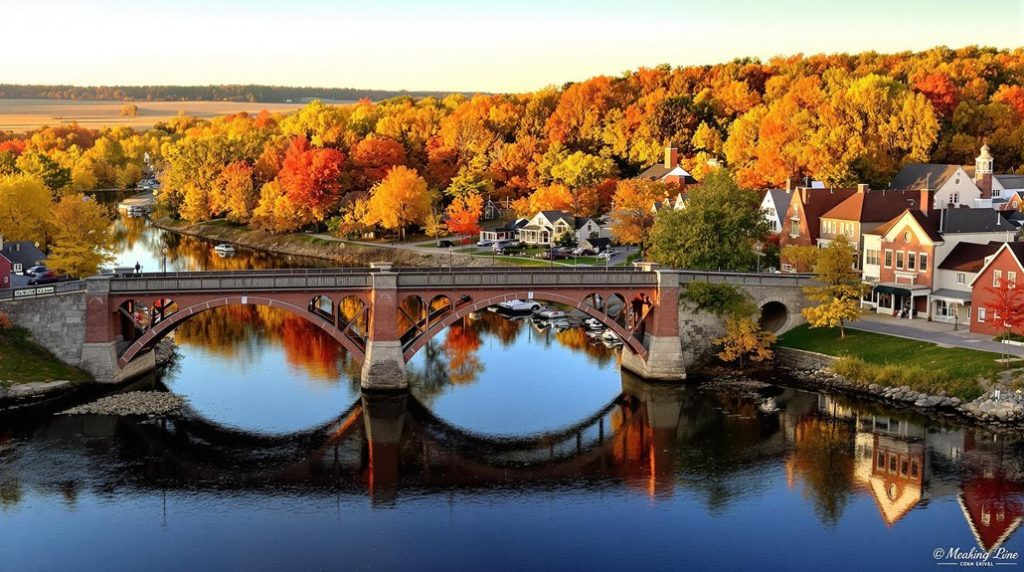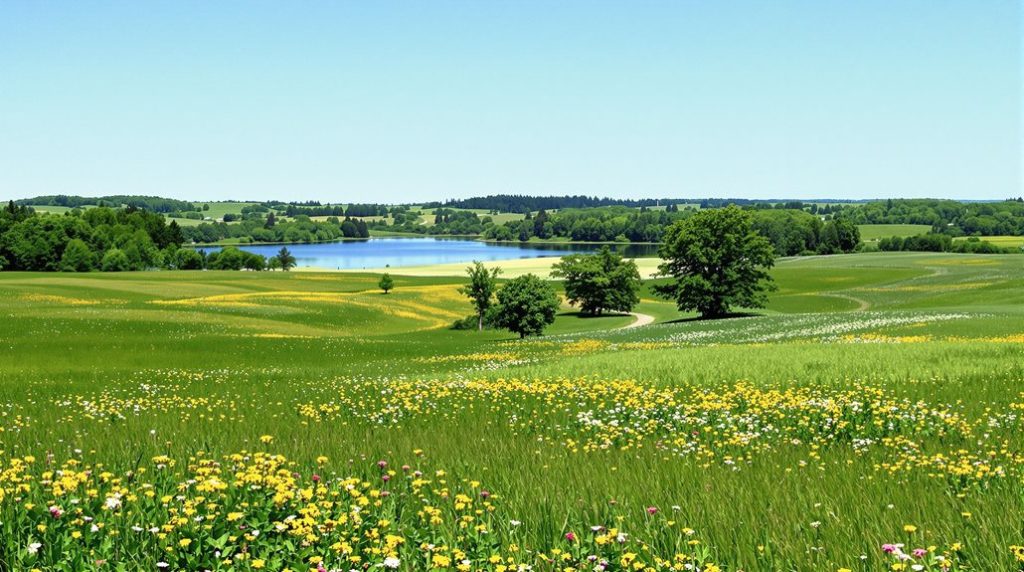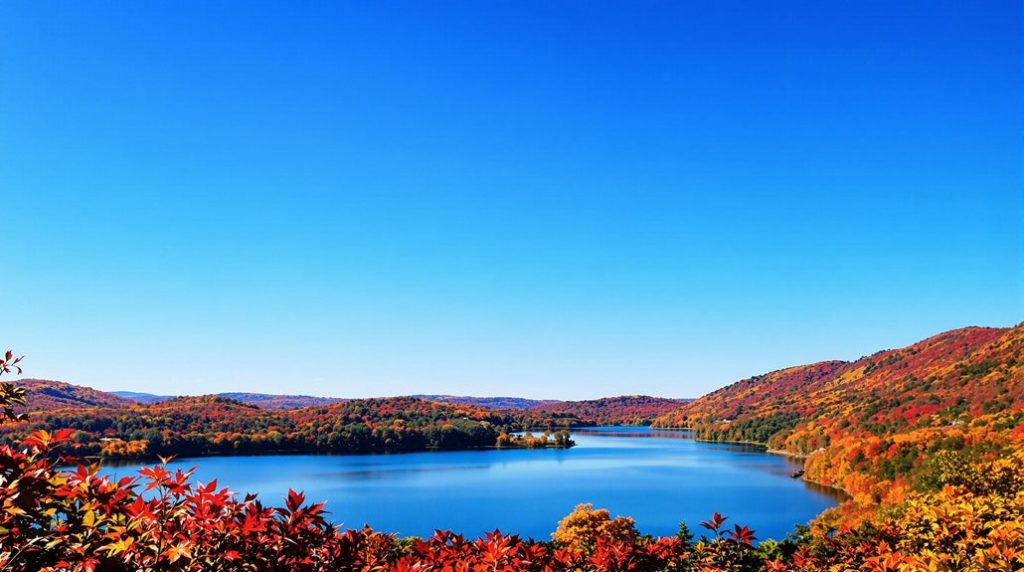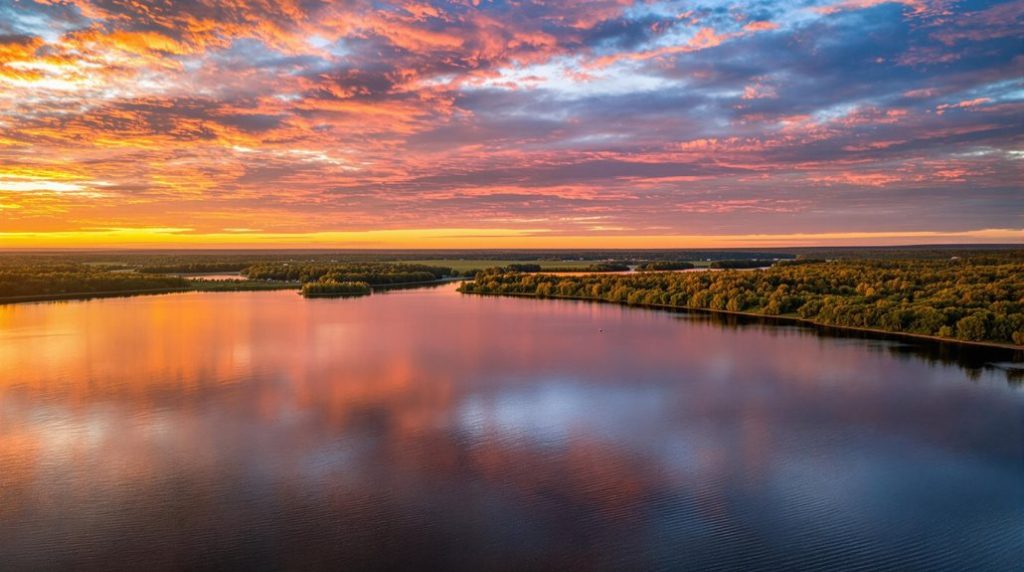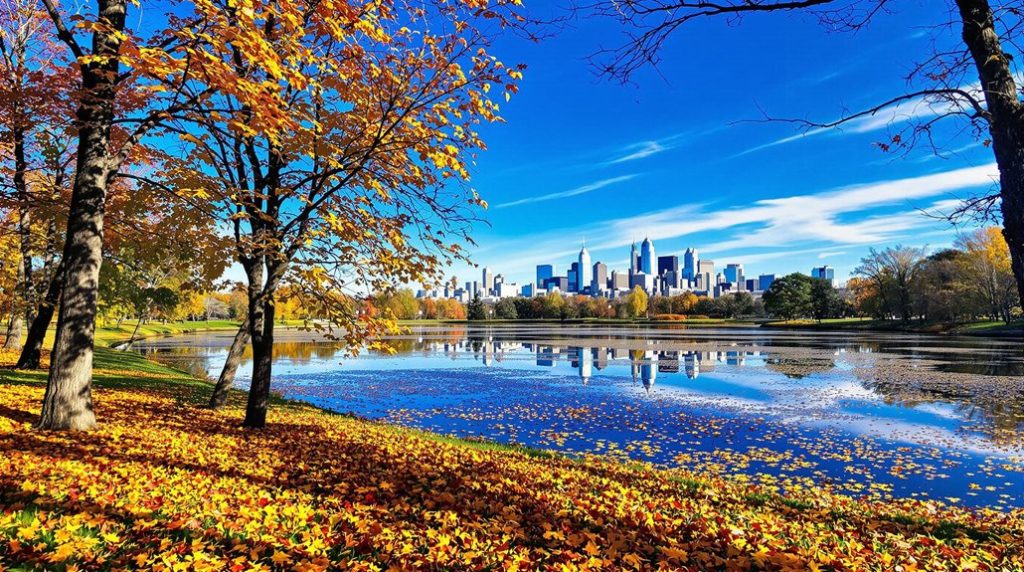Service Area
Hamel MN
Hamel, Minnesota, part of Medina, retains its small-town charm despite proximity to the Minneapolis-St. Paul metropolis. Founded by French-Canadian settlers like Lange Hamel in the 1860s, fertile soil supported agriculture. The Soo Line Railroad's expansion in 1887 and businesses like mapling contributed to growth. Today, it offers community spaces and amenities. Hamel's strong economy is bolstered by a strategic location, supporting a high standard of living for residents amidst historic preservation efforts. Further exploration reveals a deeper history and vibrant community life.
Expert Highlights
- Hamel, MN, was settled by French-Canadian pioneers in the 1860s.
- The area grew with the Minneapolis and Pacific Soo Line Railroad expansion in 1887.
- Hamel retains its small-town charm despite modern developments.
- The town features well-preserved historic buildings and community traditions.
- Hamel offers a high standard of living within the Minneapolis-St. Paul metro area.
History and Development
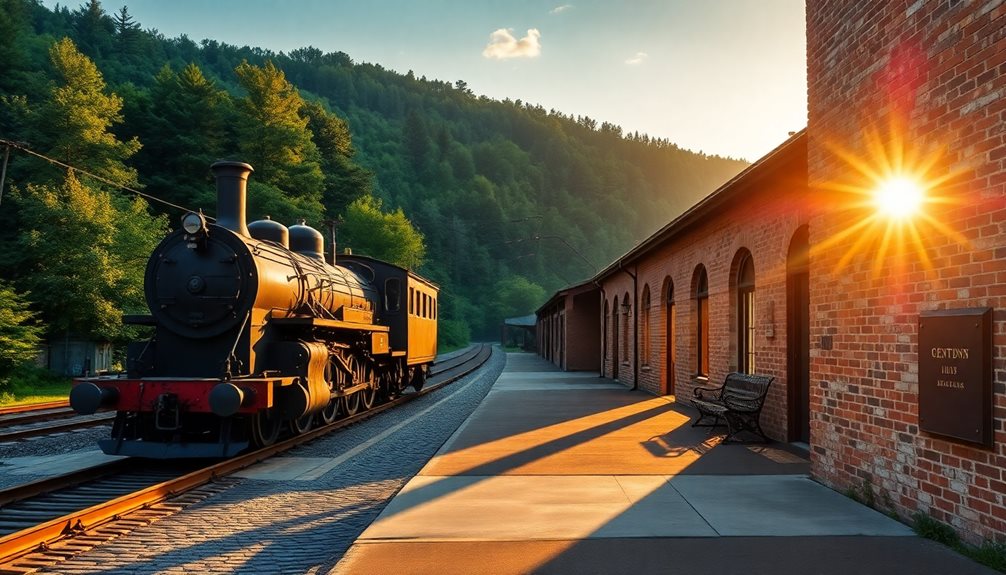
The history and development of Hamel, Minnesota, unfold against a backdrop of pioneering spirit and strategic location. French-Canadian settlers, like Lange Hamel, arrived in the 1860s, drawn by the area's fertile soil.
The Minneapolis and Pacific Soo Line Railroad expanded through Hamel in 1887, establishing a depot and boosting the local economy. This growth supported businesses such as mapling, general stores, and banking, creating a thriving community.
Over time, Hamel's charm has been preserved despite modern developments, maintaining its unique blend of history and small-town charm. Visitors can explore Hamel's local heritage through its well-preserved historic buildings and community landmarks.
Community and Amenities
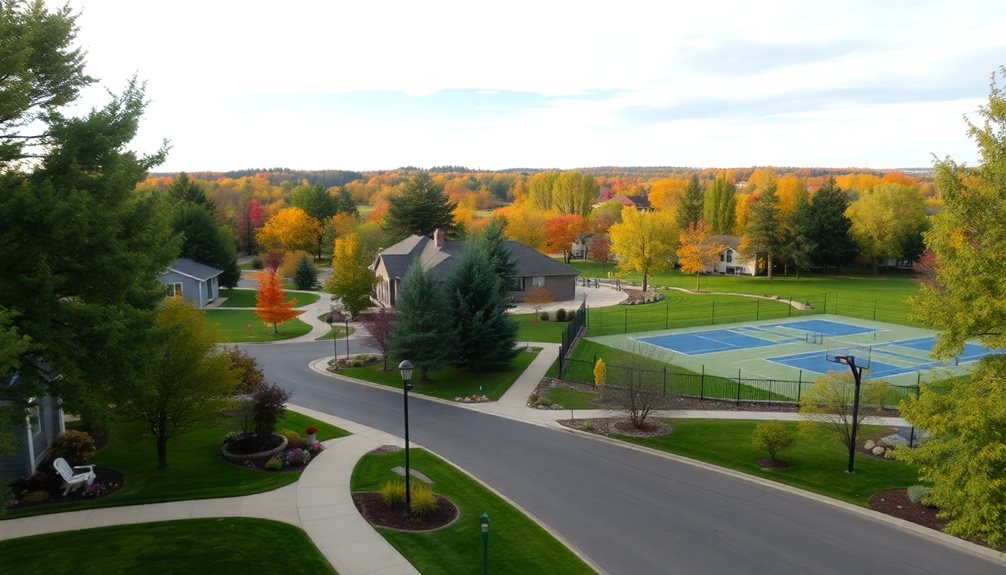
As Hamel's residents continue to value their community's traditions, they also benefit from a variety of modern amenities.
Similar to Brooklyn Park's hidden gems, the area offers unique places for locals to gather and connect with their neighbors.
The Hamel Community Building in Medina, MN, offers a conveniently located meeting space with ample seating for up to 120 banquet guests or 150 theater-style seating. It features a well-equipped kitchenette, including an industrial fridge and freezer, large sinks, and coffee maker.
The building also boasts a covered patio area overlooking a park with access to recreational activities like baseball fields and tennis courts.
Economic Overview
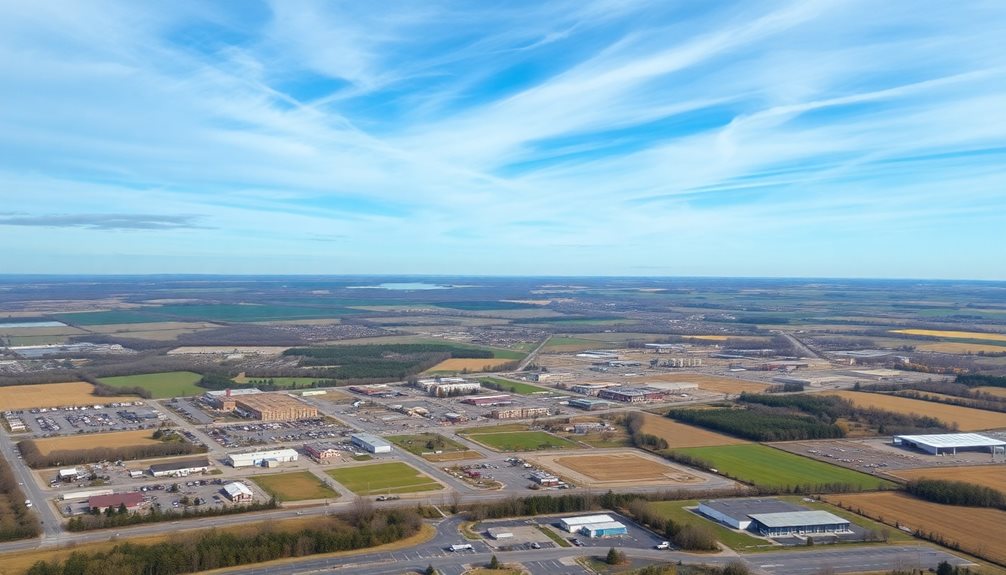
Given its advantageous location within the Minneapolis-St. Paul metropolitan area, Hamel, MN, benefits from a strong economic environment.
With an unemployment rate of about 1.5%, Hamel's job market is robust, contributing greatly to its economic vitality. The median household income is remarkably higher than both Minnesota's and the national average.
ZIP Code 55340, which encompasses Hamel, is classified as Upper Middle Class, with a median household income of $166,953. This economic profile supports a high standard of living and stability for residents.
Events and Attractions**
Hamel, MN, with its strong economic foundation, supports an array of vibrant events and attractions that enhance both the social fabric and community appeal.
Significantly, the Hamel Rodeo is a major annual event featuring multiple evening shows and a family-friendly matinee on Saturday.
Additionally, the Hamel Lions Club organizes various activities, including the Hamel Lions Rodeo Parade and a weekly flea market during warmer months.
These events contribute to the town's lively atmosphere, attracting visitors and fostering community engagement.
Expert Final Thoughts
Hamel, Minnesota, emerges as a historically vibrant community, tracing its beginnings back to the late 19th century. Initially settled by French-Canadian pioneers and developed through strategic railroad integration, Hamel thrived due to its agriculture and maple sugar industry. Despite experiencing economic and demographic shifts over time, such as the bypassing of Highway 55, Hamel retains its main street charm, offering a rich heritage amidst suburban growth.
Hassan Township MN
Hassan Township, located in northwestern Hennepin County, Minnesota, offers a blend of farmsteads and woodlands, providing scenic beauty and proximity to attractions like Long Lake. Historically, the area has had a mainly white population and a strong family-oriented environment. The median household income stands at approximately $79,158. With competitive housing dynamics and a mix of natural charm, Hassan Township attracts families and professionals alike, inviting further exploration of its unique qualities.
Expert Highlights
- Hassan Township is in Hennepin County with scenic landscapes.
- It includes part of Orono, known for high median incomes.
- Similar areas have family-oriented environments and low poverty.
- Nearby towns offer diverse housing and economic growth.
- Natural beauty and recreational opportunities are prevalent.
Location and Geography
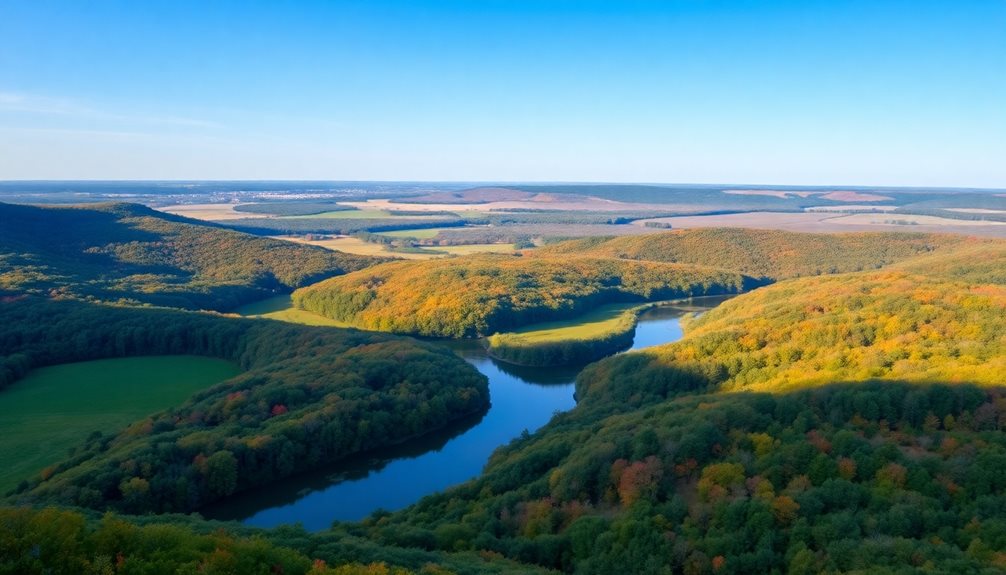
Hassan Township in Hennepin County was located in the northwestern part, with an area of about 21.3 square miles, featuring a mix of landscapes including farmsteads and woodlands. Not far from Hassan Township lies Maple Grove, a city known for its hidden natural gems and scenic beauty.
Demographics and Community
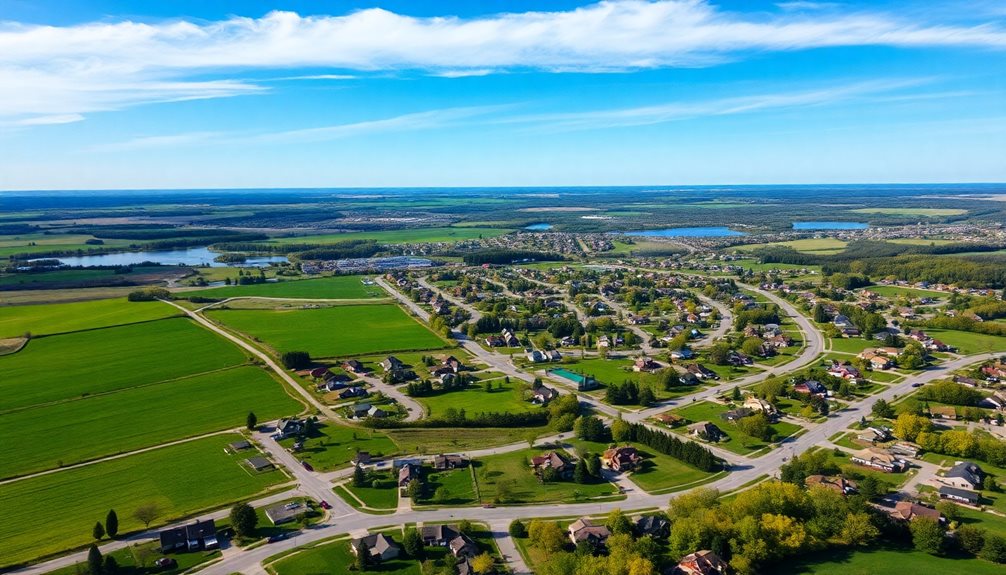
The demographic landscape of what was formerly Hassan Township is characterized by its largely white population, with a historically high percentage of residents identifying as Caucasian—specifically, 98.38% as of the 2000 census.
In terms of community attributes, Hassan Township was known for its family-oriented environment, with 81.4% of households being married couples, and 48.8% having children under 18.
The median household income was $79,158, reflecting a relatively affluent community. This setting allowed for stable family structures, contributing to a low poverty rate of 0.3% within the population.
The township's proximity to Long Lake provided residents with recreational opportunities and natural scenery throughout the year.
Housing and Real Estate
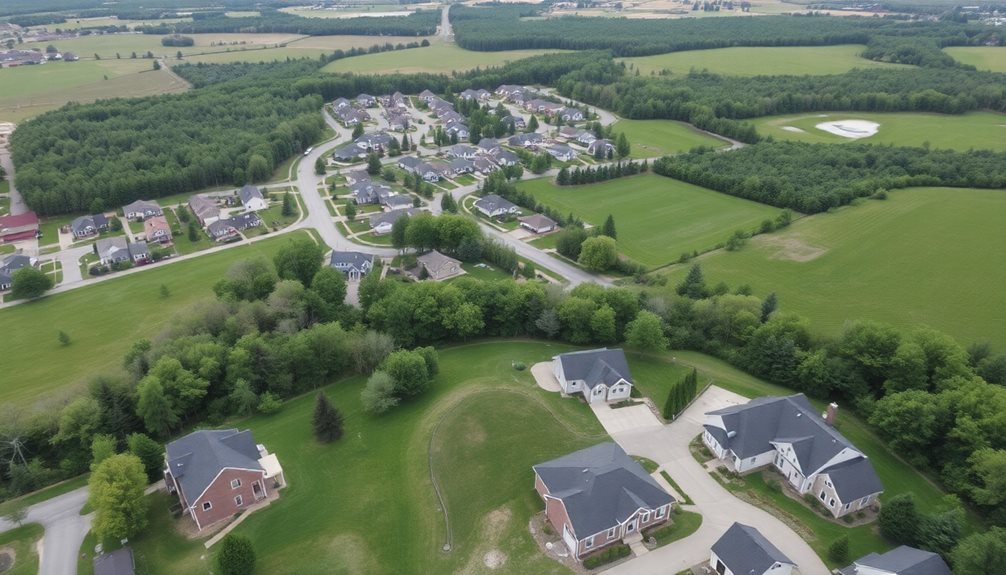
In the domain of housing and real estate, communities like those formerly part of Hassan Township exhibit dynamic market trends, largely driven by factors such as location, property values, and local demand.
Hassan Township's housing market reports a median home price of $438,440 in November 2023, a decrease from the previous year. As of February 2025, the price was $439,900, reflecting an annual decline of 8.2%.
Homes typically sell quickly, with 100% of sales occurring above the asking price and within 30 days. This marketplace illustrates a competitive environment for buyers.
Similar Locations in Minnesota**
Minnesota offers various suburban communities similar to those formerly part of Hassan Township regarding housing and real estate dynamics.
Cities like Chanhassen, Eden Prairie, and Minnetonka provide a mix of residential charm and economic growth, with diverse housing options and vibrant community activities.
Chanhassen, Eden Prairie, and Minnetonka blend residential charm with economic growth and diverse housing options.
These suburbs are known for excellent schools, recreational opportunities, and a high quality of life, attracting families and professionals alike.
They share characteristics such as scenic landscapes and thriving business environments, making them appealing alternatives.
Expert Final Thoughts
Hassan Township in Minnesota encompasses two distinct areas: Hassan Valley Township in McLeod County and the former Hassan Township in Hennepin County. While Hassan Valley Township is characterized by rural areas and natural features like the South Fork Crow River, Hassan Township in Hennepin County was urban and has been annexed by Rogers. These areas reflect different demographic and geographical profiles, each contributing uniquely to Minnesota's diverse landscape.
Dayton MN
Dayton, Minnesota, is an agricultural community established in the 1850s and named after Lyman Dayton, a St. Paul real estate investor. It was initially developed for farming and supported by timber sales to Minneapolis. As Minneapolis expanded, so did Dayton, offering private living areas, blending natural beauty with suburban amenities. Spanning 25.182 square miles, it features the Mississippi River and Diamond Lake. For deeper insights, exploring its further attractions and growth offers a more thorough understanding of this Twin Cities suburb.
Expert Highlights
- Dayton, MN, was founded in 1851 as an agricultural community.
- It is named after Lyman Dayton, a real estate investor from St. Paul.
- The city covers 25.182 square miles with lakes and water.
- It is part of the Minneapolis-St. Paul metropolitan area economically.
- Offers outdoor activities like hiking and water sports nearby.
History of Dayton
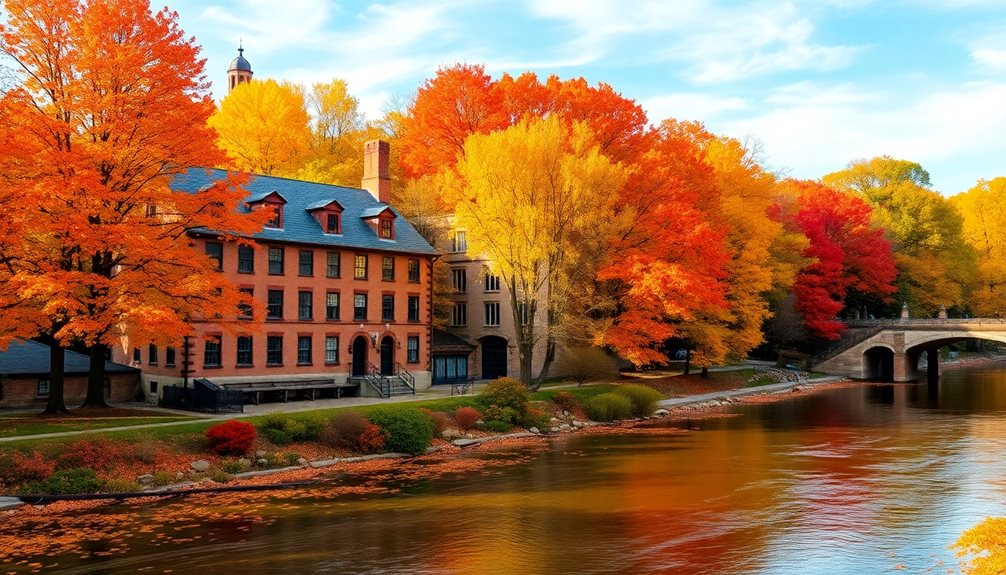
The city of Dayton, Minnesota, has a rich and multifaceted history dating back to its early settlement in 1851.
Initially, it was named after Lyman Dayton, a real estate investor from St. Paul, and developed primarily as an agricultural community. Geographically, Dayton featured forests and grasslands, which settlers cleared for farming.
During winter, residents worked in the pine forests, cutting timber for wood sales in Minneapolis. This economic activity supported year-round livelihoods for early settlers.
Over time, Dayton's growth has been influenced by Minneapolis's expansion and economic opportunities.
Today, visitors can explore Dayton's charming attractions while experiencing the city's blend of history and modern development.
Geographical Features and Attractions

Dayton, Minnesota, showcases a diverse geography, sprawling across 25.182 square miles of land and water.
Its total area includes 23.419 square miles of land and 1.763 square miles of water. Notable geographical features include the Mississippi River, Diamond Lake, and French Lake, each offering recreational activities.
The city's proximity to Elm Creek Park Reserve provides additional outdoor attractions, enhancing its appeal for nature enthusiasts seeking freedom in open spaces.
Dayton's layout combines residential areas with natural beauty, making it an attractive suburb of the Twin Cities.
Residents can visit nearby Long Lake for additional water recreation opportunities and scenic views.
Community and Local Economy
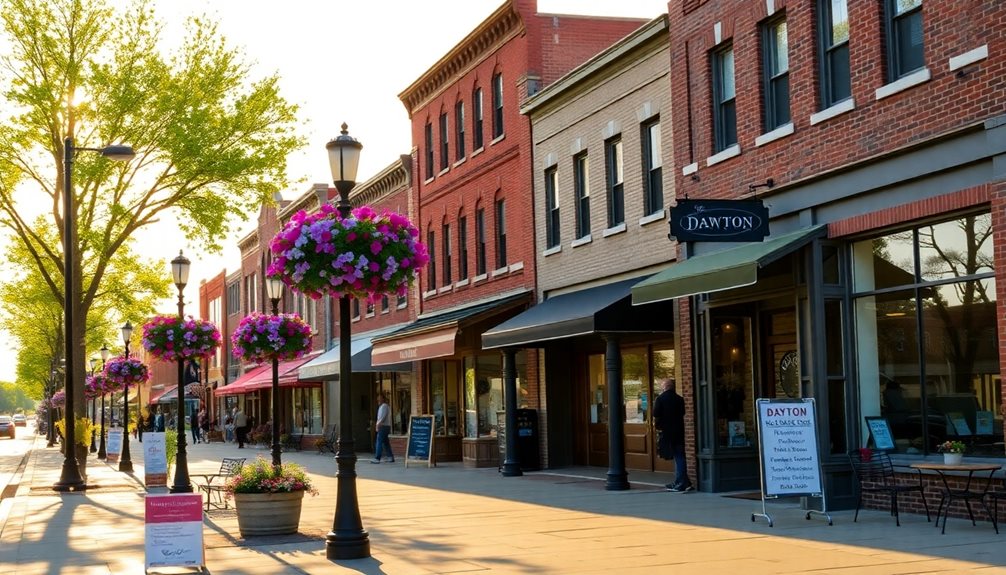
As part of the growing Minneapolis-St. Paul metropolitan area, Dayton, Minnesota, offers a strong local economy influenced by its proximity to major urban hubs.
The community has seen significant growth, with an estimated 2023 population of 10,157, compared to 7,262 in the 2020 census. The median household income in Dayton is substantial, at $178,661, reflecting its appeal as a suburban site for businesses and families seeking urban amenities with a more rural lifestyle.
A diverse racial composition aids in fostering a culture that values freedom and community engagement.
Planning Your Visit**
To plan a visit to Dayton, Minnesota, it is essential to understand the options available for recreation and exploration within this vibrant suburb.
Visitors can enjoy a mix of outdoor activities and local attractions.
Some highlights include:
- Recreational Sites: Explore Elm Creek Park Reserve and the nearby Mississippi National River & Recreation Area for hiking and water activities.
- Local Features: Visit the Eastman Nature Center for a glimpse into local biodiversity.
- Community Events: Engage with the local community through cultural events and festivals that foster connection and cultural exchange.
Expert Final Thoughts
Dayton, Minnesota, offers a rich blend of historical and geographical significance. The city's development was shaped by settlers exploiting its fertile soil, while its French-Canadian heritage adds cultural depth. Geographical features include a mix of forests and waterways, making it attractive for both nature enthusiasts and historians. With a strong sense of community and local economic importance, Dayton invites visitors to explore its historical landmarks and natural beauty.
Albertville MN
Albertville, MN, hosts vibrant community events like the annual Friendly City Days, featuring garage sales, carnival rides, and fireworks. Local attractions include Albertville Premium Outlets and Cedar Creek Golf Course, as well as natural spots like Central Park. The St. Michael-Albertville School District supports a strong education system, contributing to the area's economic stability with a median income of $126,307. Further exploration reveals more about its recreational and cultural offerings.
Expert Highlights
- Albertville, MN, has a projected population of 9,493 in 2025.
- Albertville Friendly City Days features a city-wide garage sale and carnival rides.
- The city offers outdoor attractions like Cedar Creek Golf Course.
- Median income is $126,307, reflecting a strong local economy.
- Albertville Premium Outlets provide shopping experiences for visitors.
Community Events & Activities
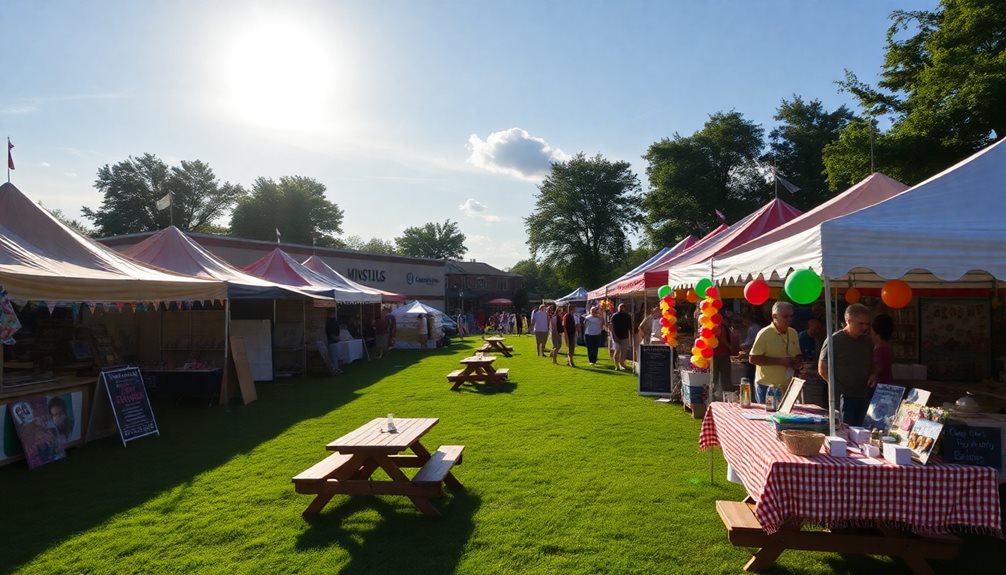
As Albertville, Minnesota, continues to grow and thrive, community events and activities play a pivotal role in fostering a sense of unity and shared experience among its residents.
The city hosts events like Albertville Friendly City Days, featuring a city-wide garage sale, carnival rides, live music, and fireworks, typically occurring from June 5-9.
Additionally, Family Youth Community Connections organizes activities such as Reading in the Park and Father/Daughter Dances throughout the year, catering to diverse age groups and interests within the community.
These events promote social cohesion and civic engagement.
Visitors can discover many hidden gems while exploring the charming streets of Albertville throughout the year.
Local Attractions
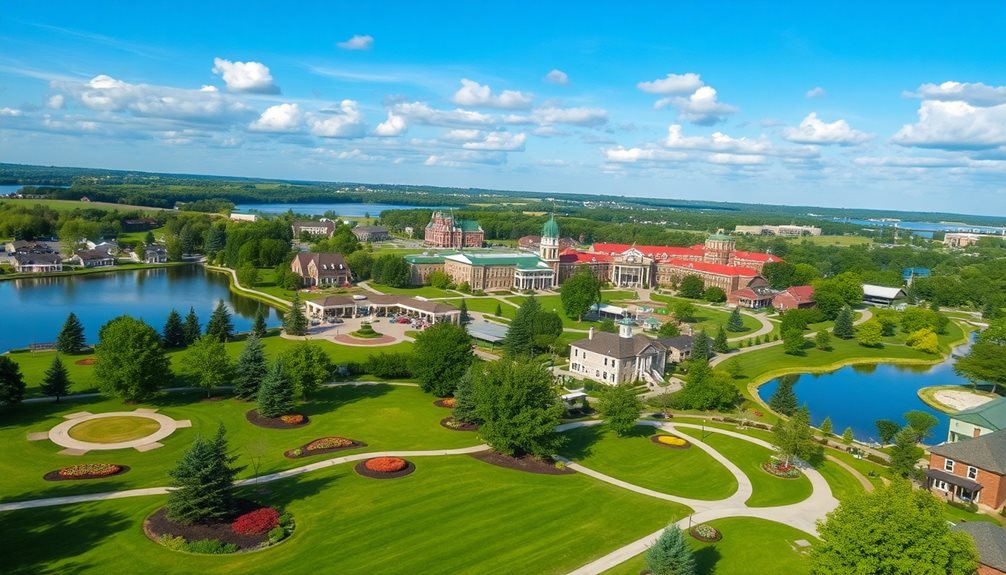
Albertville, Minnesota, offers a diverse array of local attractions that cater to both residents and visitors.
Key attractions include the Albertville Premium Outlets for shopping, Cedar Creek Golf Course for outdoor enthusiasts, and Central Park with its community facilities.
Nature enthusiasts can visit Magnolia Landing Park or explore Mud Lake and Karston Ave Lake.
These attractions provide a mix of leisure, entertainment, and natural experiences, making Albertville a versatile destination.
Albertville offers a diverse mix of leisure, entertainment, and outdoor experiences, creating a versatile destination.
The area supports a balance of shopping, golfing, and outdoor activities.
Visitors can easily explore neighboring St. Michael attractions while staying in Albertville.
Education & Economy
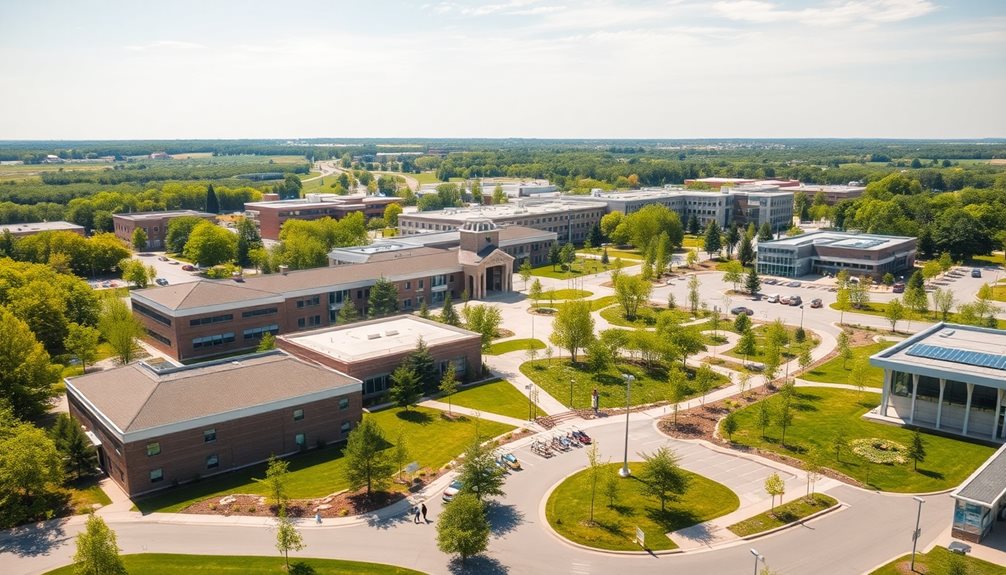
The educational landscape in the St. Michael-Albertville area is marked by a strong focus on academic excellence. The St. Michael-Albertville School District serves over 6,670 students, offering a thorough curriculum and extracurricular activities.
Key educational highlights include:
- Strong Teacher Support: High teacher devotion to student success.
- Diverse Programs: Extensive arts and sports options.
- College Preparation: High graduation rates and competitive test scores.
- Facilities: Well-maintained schools and resources.
Economically, Albertville benefits from a strong local economy with a median income of $126,307.
Nature & Recreation**
Nature and recreation in and around Albertville, MN, abound with opportunities that cater to diverse interests, from serene outdoor experiences to engaging community events.
Central Park is a hub for activities, including free summer concerts and reading programs for kids. Nearby, natural attractions like Crow-Hassan Park Reserve offer ample wildlife spotting opportunities, while Beebe Lake Regional Park provides a clear and sandy swimming beach.
Community events, such as the Albertville Friendly City Days, add to the area's lively recreational scene with carnivals and family-friendly festivities.
Expert Final Thoughts
Albertville, MN, offers a diverse range of community events like the Albertville Friendly City Days, featuring parades and live music, along with local attractions such as the Albertville Premium Outlets. The area's economy is influenced by retail and commerce. Nature and recreation opportunities are available through nearby parks and trails. Education supports local development, ensuring a well-rounded community experience.
Hanover MN
Hanover, Minnesota, lies along the Crow River, spanning Wright and Hennepin counties. Historically, it was inhabited by diverse American Indian tribes, including the Dakota. German immigrant Jacob Vollbrecht arrived in 1856, and the village was incorporated in 1891. Today, Hanover thrives as a farming community with preserved architecture. Its location near the Twin Cities offers strategic benefits. To uncover more about Hanover’s attractions and community life, one can explore its rich history and modern developments.
Expert Highlights
- Location and History: Hanover, MN, is located on the Crow River and was originally inhabited by American Indian tribes.
- Founding: Jacob Vollbrecht, a German immigrant, arrived in 1856, leading to its founding.
- Incorporation: The village was officially incorporated in 1891 as a farming community.
- Amenities: Offers scenic parks and community spaces, enhancing outdoor activities.
- Events: Hosts an annual Harvest Festival with a 5K run and Miss Hanover competition.
History of Hanover
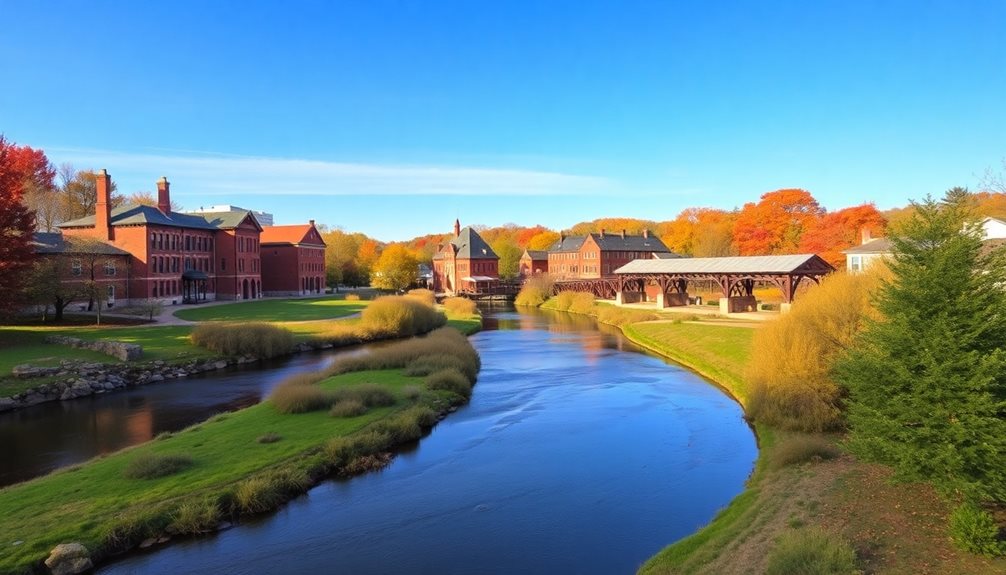
The history of Hanover, Minnesota, unfolds as a narrative of settlement and growth, situated on the banks of the Crow River where, once, the only inhabitants were members of diverse American Indian tribes, particularly the Dakota Indians, who utilized the woods and waters for game and resources.
Jacob Vollbrecht, a German immigrant, arrived in 1856, pioneering the area now known as Hanover, named after his hometown in Germany.
The village was officially incorporated in 1891, marking a significant milestone in its development as a thriving farming community.
Today, visitors can discover the charm of this historic riverside town through its preserved architecture and community spirit.
Natural Attraction and Settlement
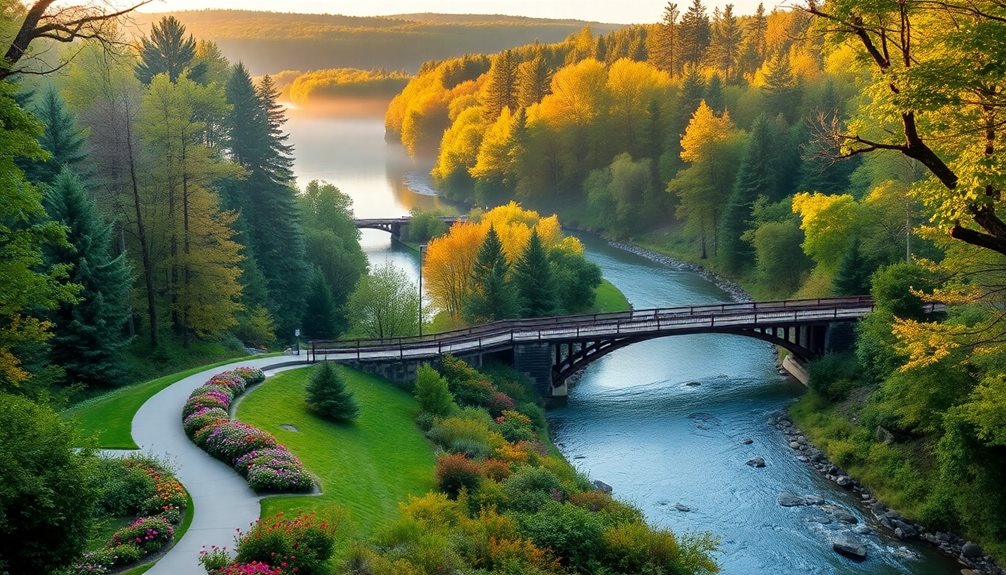
Hanover, Minnesota, situated along the Crow River, showcases a blend of natural attractions and human settlement that have evolved over time. Natural attractions include parks and riverside scenery, appealing to those seeking freedom in the outdoors. Many residents enhance their properties with concrete driveway installation to maintain the area’s aesthetic appeal while ensuring durability in Minnesota’s climate. Key features are summarized below:
| Attractions | Description | Accessibility |
|---|---|---|
| Crow-Hassan Park | Natural preserve with wilderness trails | Car and on-foot |
| River District | Community space along the Crow River | Pedestrian |
| Orchard Gardens | Local gardens with scenic views | On-foot |
| Riverside Park | Recreational area with green spaces | Easy parking |
| Hanover Settlers Park | Historical site with local significance | Accessible paths |
Community Development and Modern Life

Community growth and infrastructure development in Hanover, Minnesota, are greatly influenced by its strategic location within the Twin Cities metropolitan area and its presence in both Hennepin and Wright Counties.
Developments like Crow River Heights and Bridges At Hanover offer custom-built homes with amenities such as community parks, supporting a blend of rural charm and modern living.
Hanover’s proximity to Maple Grove and Albertville further enhances its appeal, fostering a thriving city center with above-average education options and a scenic Downtown River District along the North Crow River.
Points of Interest and Events
Located in the heart of Minnesota, discussions about points of interest in Hanover necessarily encompass its scenic parks and cultural sites.
Some notable attractions include:
- Crow-Hassan Park Reserve
- Hanover Historical Society of Minnesota
- Cardinal Circle Park
- Hanover Settlers Park
- Le Musique Room
Hanover also hosts events like the annual Harvest Festival, featuring activities such as a 5K run and Miss Hanover competition, which foster community engagement and celebration.
Expert Final Thoughts
Hanover, Minnesota, has evolved markedly since its incorporation in 1891, driven by German settlers like the Vollbrecht brothers. The town’s natural attractions, including the Crow River, supported early farming and craftsmanship. Today, it features historic sites like the 1885 Hanover Bridge and hosts events like the annual Harvest Festival. With a population of over 3,500 as of 2020, Hanover continues to grow while preserving its cultural heritage through efforts by the Hanover Historical Society.
Independence MN
Independence, Minnesota, combines rural charm with suburban conveniences, offering a unique lifestyle. Residents enjoy outdoor activities like biking, boating, and camping within Tamarack Park and Baker Park Reserve. Community values are reflected in historic sites like Pioneer Cemetery and events at the Twin Cities Polo Club. The city's infrastructure guarantees safe mobility, supporting a blend of natural tranquility and social interaction. Exploring deeper reveals more about Independence's engaging culture and natural attractions.
Expert Highlights
- Located in western Hennepin County, MN.
- Blend of rural tranquil and suburban amenities.
- Near popular parks like Lake Rebecca Park Reserve.
- CSAH 92/TH 12 intersection improves safety.
- Access to diverse outdoor recreational activities.
Natural Attractions and Activities

Independence, Minnesota, a picturesque city nestled west of the Twin Cities, boasts an array of natural attractions and activities that cater to diverse interests and preferences.
Residents and visitors alike can enjoy Tamarack Park with its baseball field and playground, while Pioneer Park offers a disc golf course.
The Luce Line Trail provides extensive opportunities for biking, hiking, and cross-country skiing.
The Luce Line Trail offers biking, hiking, and cross-country skiing opportunities.
Nearby, Lake Rebecca Park Reserve features biking, boating, and fishing, while Baker Park Reserve offers significant year-round recreation including camping and snowshoeing.
These parks guarantee a vibrant outdoor experience.
Small town charm radiates throughout Independence's natural spaces and recreational areas.
Community and History

While nestled within a larger metropolitan area, the city in question benefits from a unique blend of rural charm and suburban conveniences, thereby creating a rich tapestry of community and historical significance. The city shares similar community values to nearby Golden Valley, Minnesota while maintaining its own distinct character.
| Feature | Description | Impact |
|---|---|---|
| Pioneer Cemetery | Historic burial ground, used by pioneers | Cultural heritage |
| Twin Cities Polo Club | Athletic events, social gatherings | Community engagement |
| YMCA Camp Ihduhapi | Youth recreation, natural education | Environmental awareness |
This blend enhances the city's sense of independence and community cohesion.
Lifestyle and Amenities
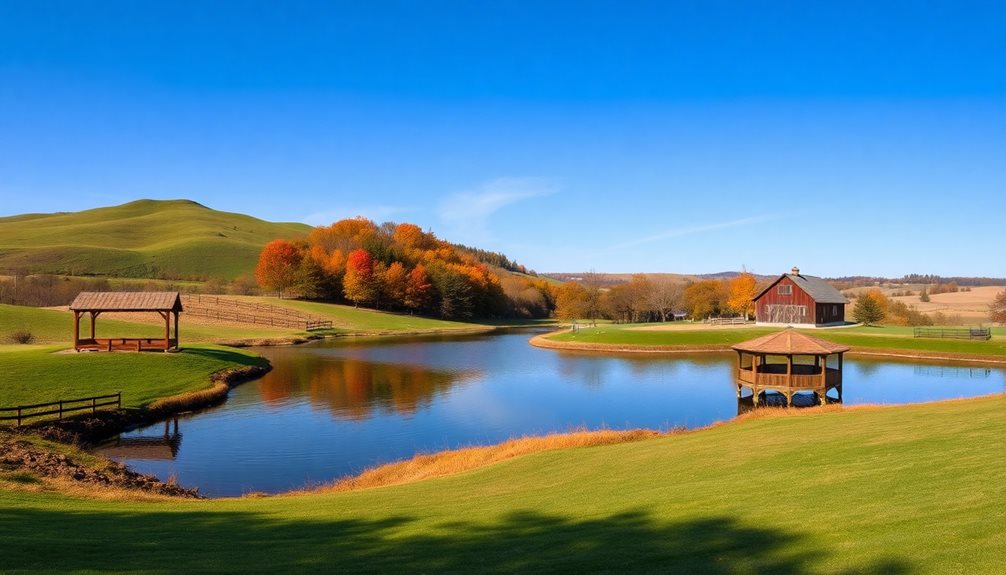
The city's unique lifestyle and amenities reflect its blend of rural tranquility and suburban convenience, offering residents a mix of outdoor activities and modern comforts.
Residents can enjoy nearby nature reserves and lakes, while also accessing amenities like gated communities and sports facilities.
Explore nearby nature reserves and lakes, alongside gated communities and sports facilities, for a holistic living experience.
For instance, Motor Condos at Independence provide a blend of technology and recreational spaces, catering to car enthusiasts and collectors.
Additionally, community events and social gatherings foster a sense of belonging.
Infrastructure and Accessibility**
Several key infrastructure projects underscore the city's commitment to enhancing accessibility and connectivity. Remarkably, the CSAH 92/TH 12 intersection improvements have greatly improved safety and mobility in Independence, bolstering its infrastructure.
| Infrastructure Project | Description |
|---|---|
| CSAH 92/TH 12 Improvements | Enhanced safety with grade separation and roundabout |
| Hwy 12 Safety Coalition | Supports safety initiatives along Hwy 12 |
| Intersection Upgrades | Ongoing collaboration with MnDOT and Hennepin County |
Expert Final Thoughts
Independence, MN, offers a serene blend of natural beauty and rural charm, featuring rolling hills, lakes, and wooded areas. Its history is marked by transformation from a Native American haven to a European settlement site. The community boasts a strong economic base with high average incomes and a low poverty rate. Residents enjoy access to outdoor activities like golfing and water sports, alongside local amenities and proximity to larger cities like Minneapolis. Despite a small population, it remains an attractive locale for those seeking a peaceful lifestyle amidst natural surroundings.
Orono MN
Orono, Minnesota, established in 1858 alongside Minnesota's statehood, was initially part of Excelsior Township before becoming Medina Township in 1868. In 1889, it formed its own township named after Orono, Maine. The city's incorporation in 1955 marked a blend of rural charm and upscale amenities. Orono offers scenic Lake Minnetonka access and cultural events, supporting its vibrant community culture and academic excellence. This blend has made Orono a desirable destination with much more depth to explore.
Expert Highlights
- Orono established in 1858, part of Excelsior then Medina Township.
- Became an independent township in 1889, named after Orono, Maine.
- Incorporated as a city in 1955 near Lake Minnetonka.
- Offers rural charm and upscale living with lake activities.
- Known for academic excellence and strong community culture.
Historical Background
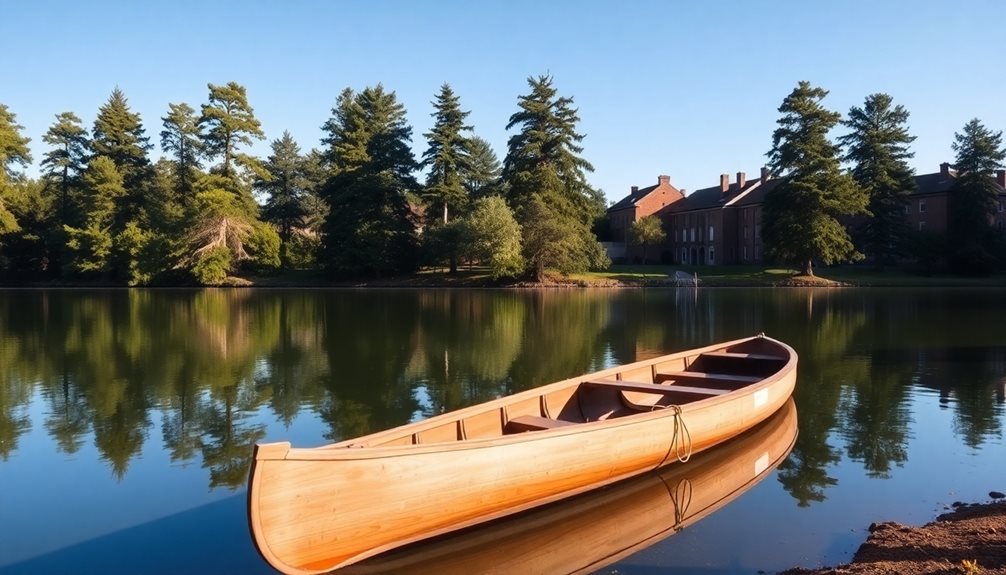
The historical background of Orono, Minnesota, begins with its origins in 1858, the same year Minnesota achieved statehood.
Originally part of Excelsior Township, it later became part of Medina Township in 1868.
In 1889, Orono was established as an independent township, named after Orono, Maine, thanks to settlers like Major George Brackett.
The area's strategic location by Lake Minnetonka facilitated growth, especially through dairy farming and apple orchards.
Situated by Lake Minnetonka, Orono grew through dairy farming and apple orchards, leveraging its strategic location for prosperity.
Orono was incorporated as a city in 1955, evolving into an affluent municipality with a strong emphasis on community and educational excellence.
Today, visitors can discover many hidden gems throughout this charming lakeside community.
Lifestyle and Amenities
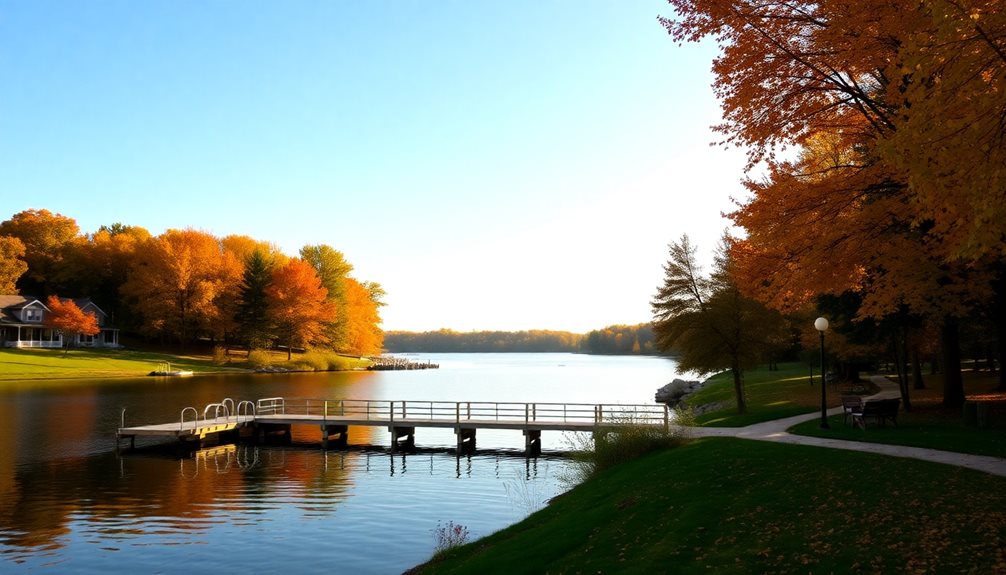
Residents of Orono, Minnesota, enjoy a lifestyle that seamlessly blends rural charm with upscale living amenities. The proximity to Lake Minnetonka offers ample opportunities for boating, sailing, and paddleboarding.
Nearby cities like Wayzata and Excelsior provide fine dining and cultural events. Orono itself boasts scenic parks and nature reserves, including Noerenberg Memorial Gardens.
The community is tight-knit, with annual events like Summerfest fostering connections among residents. This balance of natural beauty and urban convenience creates an appealing environment for those seeking a peaceful yet connected living experience.
The area's low tax rates are an added advantage. The charm of Wayzata adds to the allure of living in this Lake Minnetonka region.
Community and Culture
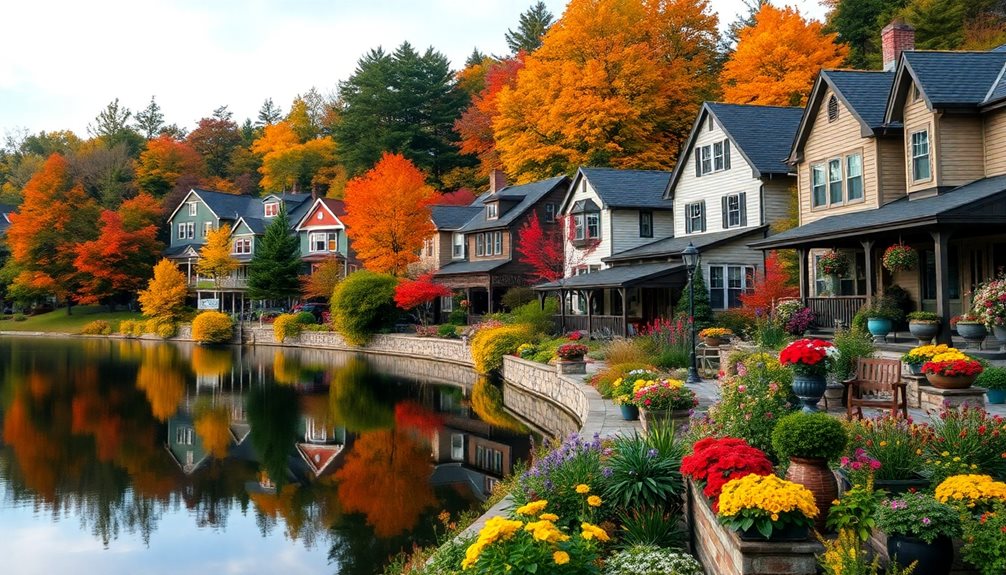
Orono, Minnesota, cultivates a vibrant community culture that is deeply ingrained in its rural heritage, while also embracing a modern, affluent lifestyle.
Orono blends rural roots and modern affluence, fostering a vibrant community culture.
The town hosts numerous community events, including Summerfest, which fosters connections among residents through live music and activities.
Orono's strong sense of community is further enhanced by its proximity to local amenities and the scenic Lake Minnetonka, offering residents a unique blend of nature and urban conveniences.
This harmonious balance guarantees that residents enjoy both tranquil living and active engagement in local culture.
Education and Real Estate**
As Orono, Minnesota, supports a thriving community with rich cultural events and a natural backdrop like Lake Minnetonka, its highly regarded educational system plays a vital role in enhancing the quality of life for its residents. The Orono School District is known for its academic excellence and single-campus setting. Real estate is attractive due to the district's reputation and scenic lakeside location.
| Feature | Orono School District | Real Estate |
|---|---|---|
| Notable Aspect | Highly performing students | Lakeside views |
| Academic Focus | Personalized and rigorous learning | Community support |
| Community Role | Central to local life | Desirable location |
Expert Final Thoughts
Orono, Minnesota, offers a blend of historical charm and modern luxury. Founded in 1889, it has evolved from an agricultural town to an affluent lakeside community. Residents enjoy access to Lake Minnetonka, robust community events, and a strong educational system. With a population of approximately 8,000, Orono maintains its rural essence while providing proximity to urban amenities, making it an attractive location for those seeking a tranquil yet connected lifestyle amidst natural beauty.
Long Lake MN
Long Lake, Minnesota, is characterized by a continental climate with warm summers reaching highs of 83°F and cold winters around 5°F. Annual precipitation includes about 32 inches of rain and 51 inches of snow. The area offers recreational activities like fishing and boating on Long Lake, alongside parks with amenities for various outdoor pursuits. With a strong focus on environmental conservation, Long Lake supports both natural preservation and economic development, providing opportunities to engage further with its unique blend of ecology and community initiatives.
Expert Highlights
- Long Lake, MN, is approximately 955 feet above sea level.
- It features warm summers (up to 83°F) and cold winters (as low as 5°F).
- Annual precipitation includes 32 inches of rain and 51 inches of snow.
- Recreational activities include fishing, swimming, and boating on Long Lake.
- The local economy has a median household income of about $75,972.
Geography and Climate
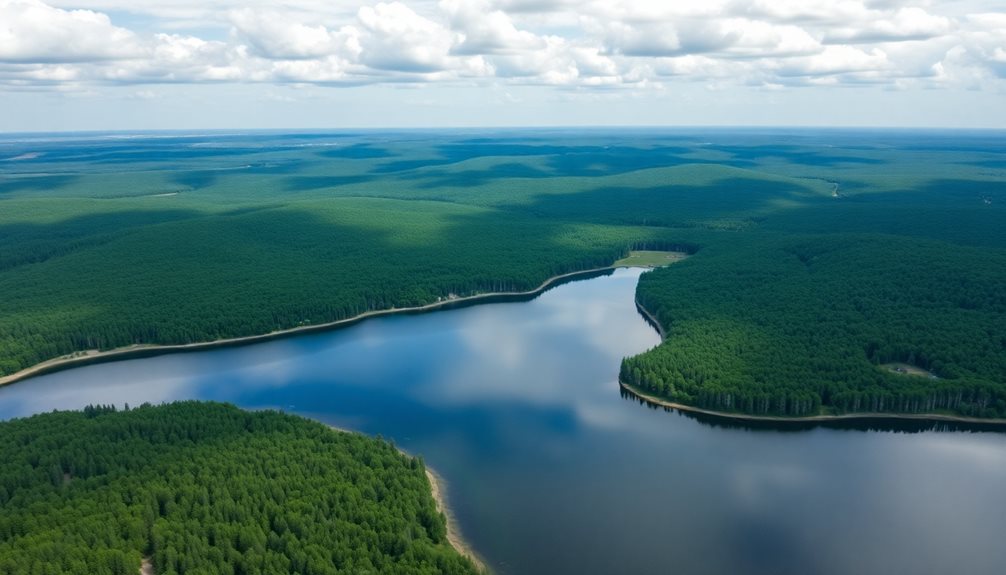
Geography and climate play integral roles in defining the character of Long Lake, Minnesota, a locality situated at an elevation of approximately 955 feet.
Long Lake experiences a continental climate with warm summers, averaging highs around 83°F, and cold winters, with lows around 5°F. The area receives about 32 inches of rain and 51 inches of snow annually, leading to diverse seasonal experiences.
This climate supports a typical Upper Midwestern environment, offering both the advantages of warmer seasons and the challenges of cold winter months.
The Long Lake website provides comprehensive details about the natural features and environmental conditions of this Minnesota community.
Recreational Activities
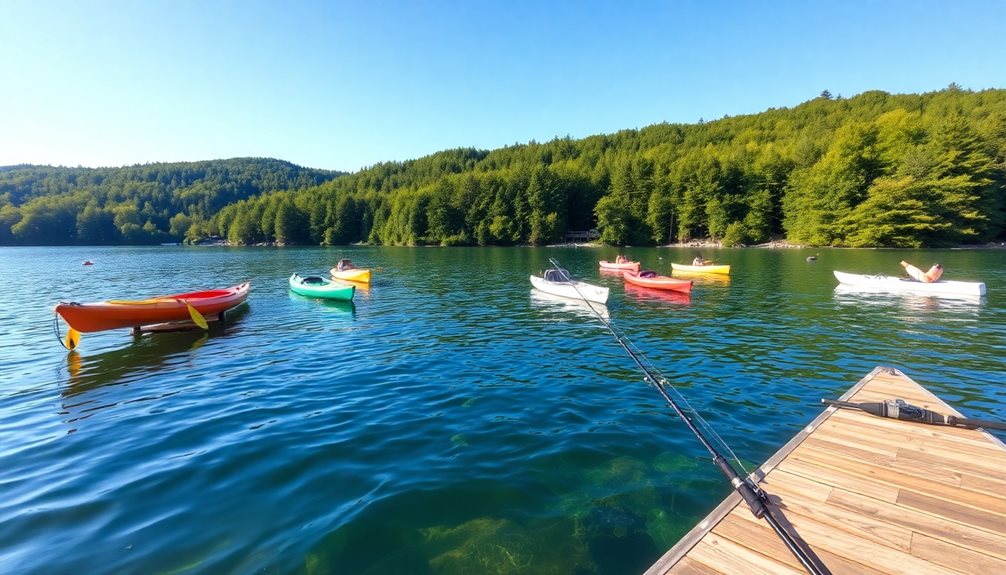
Long Lake, Minnesota, offers a diverse array of recreational activities that cater to various interests.
Outdoor enthusiasts can enjoy fishing, swimming, and boating on the lake. Parks in the area, such as Nelson Lakeside Park and Long Lake Regional Park, provide amenities like volleyball courts, hiking trails, and picnic shelters.
The Long Lake Conservation Center offers naturalist programs and camps, fostering an immersive nature experience. These activities provide opportunities for physical engagement and connection with nature. For those planning outdoor projects, concrete solutions experts at Legacy General Services can help create durable outdoor living spaces.
Local Community and Economy
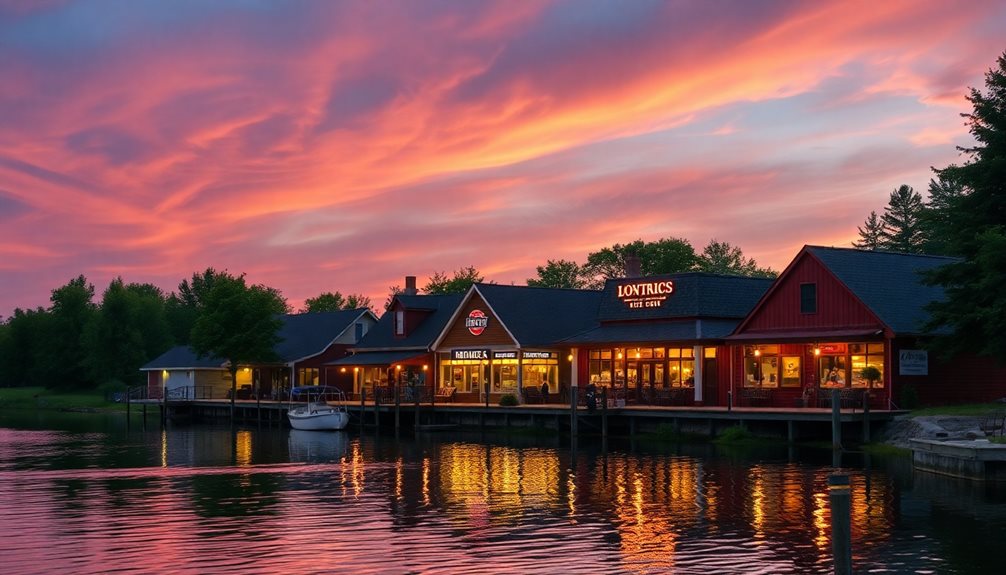
As Minnesota's diverse regions continue to develop economically, communities like those near Long Lake play a significant role in integrating natural resources with local economic development.
Long Lake's economy is characterized by a strong median household income of $75,972, with an average income per resident of $45,079. The area exhibits a mix of growth and challenges, with a job market decrease of -3.6%, but projected future growth of 36.9%.
Local organizations often focus on preserving nature and balancing development with conservation efforts to guarantee sustainable economic practices.
Environmental Conservation**
Environmental conservation in the regions surrounding Long Lake, Minnesota, is driven by initiatives that seek to preserve natural resources while aligning them with economic development. Facilities like the Long Lake Field Station focus on water quality, prairie restoration, and wildlife behavior, emphasizing sustainable practices.
The Long Lake Conservation Center, with its 760 acres, offers educational programs, fostering an appreciation for nature. These efforts promote environmental stewardship and support local ecosystems, ensuring that natural areas thrive while contributing to the regional economy.
Conservation sites like these are essential for balancing environmental health and economic growth effectively.
Expert Final Thoughts
Long Lake, Minnesota, features a continental climate with warm summers and cold winters, receiving 32 inches of rain and 51 inches of snow annually. Recreational activities capitalize on the lake's 284 acres and 33-foot depth. The local community fosters a standard economy, while environmental efforts focus on maintaining water quality through regulations such as the slow-no wake restriction. Environmental conservation plays an essential role in preserving the area's natural beauty and ecosystem.
Wayzata MN
Wayzata, Minnesota, lies 12 miles west of Minneapolis on Lake Minnetonka's north shore. Named after the Dakota word *wazíyata*, meaning "north shore," it evolved from a Native American settlement to a resort town and suburban community. Wayzata offers attractions like the historic Wayzata Depot and scenic trails, as well as sophisticated shopping and dining options. Its blend of history, outdoor activities, and cultural events makes it an appealing destination, with much more to explore beyond its charming exterior.
Expert Highlights
- Wayzata, MN, is located 12 miles west of Minneapolis on Lake Minnetonka's north shore.
- The city name comes from the Dakota word *wazíyata*, meaning "north shore."
- It's an affluent suburb with upscale shopping and scenic views.
- Activities include boating on Lake Minnetonka and hiking on the Dakota Rail Regional Trail.
- Wayzata features vibrant community events like the Wayzata Art Experience.
History and Background
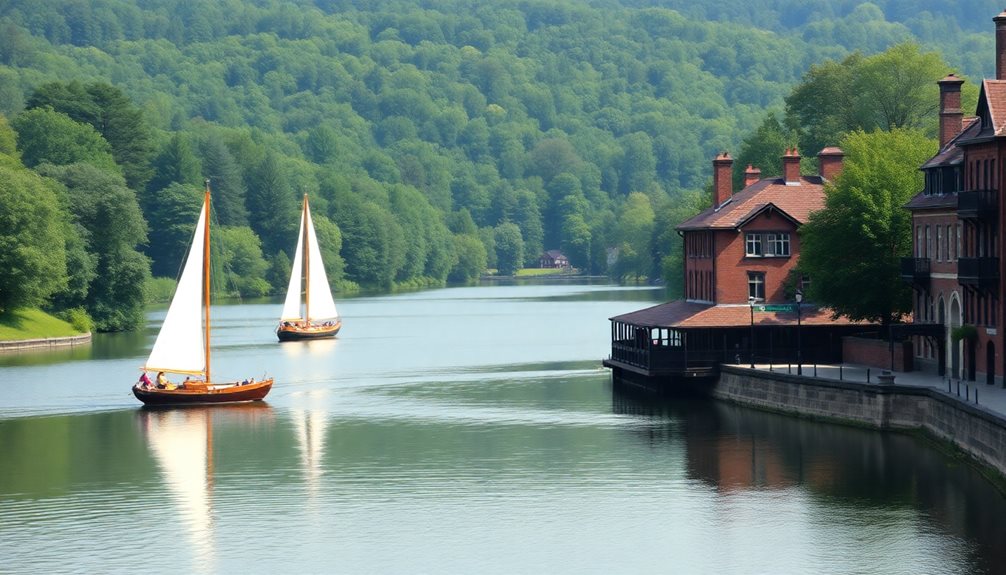
Wayzata, Minnesota, is situated 12 miles west of Minneapolis on the northern shore of Lake Minnetonka, an expansive body of water that has played a pivotal role in the city's historical development.
Originally named after the Dakota word *wazíyata*, meaning "north shore," this area was treasured by the Mdewakanton Dakota for hunting and fishing. European settlement began in 1854, with significant expansions facilitated by the Saint Paul and Pacific Railroad in 1867, transforming Wayzata into a key transportation hub and later a resort town during the late 1800s.
Its economy highlights a blend of agriculture and tourism. The city's Lake Minnetonka location continues to attract visitors seeking recreational activities and scenic beauty.
Attractions and Activities
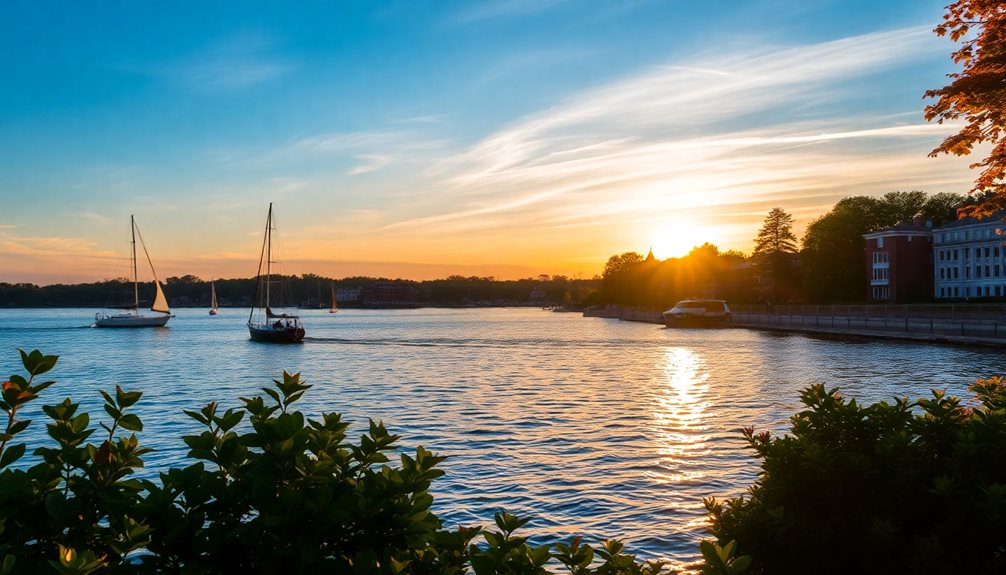
Beyond its rich historical context and stunning natural scenery, the area surrounding Lake Minnetonka offers a plethora of attractions and activities that have drawn visitors and residents alike for generations. Just a short drive from Independence, Minnesota, visitors can enjoy additional recreational opportunities and small-town charm.
| Attraction | Description |
|---|---|
| Noerenberg Memorial Gardens | Peaceful gardens by Lake Minnetonka |
| Wayzata Depot | Historic train station turned museum |
| Dakota Rail Regional Trail | Scenic trail for biking and walking |
| Wayzata Brew Works | Live music and craft beer offerings |
| Lake Minnetonka | Water activities like boating and kayaking |
Community Events and Festivals

How do community events and festivals contribute to the vibrant cultural fabric of an area like Wayzata, Minnesota? They bring people together, creating a sense of community and cultural richness.
Events like the Wayzata Art Experience, a two-day celebration of art, music, and food, and James J. Hill Days, a three-day festival featuring a carnival, street market, and live music, attract visitors and locals alike.
These festivals foster connection and joy in Wayzata, celebrating its charm and heritage.
Lifestyle and Amenities**
The lifestyle in Wayzata, Minnesota, is characterized by an appealing blend of scenic natural beauty, sophisticated amenities, and a small-town charm. Residents enjoy upscale boutiques, gourmet restaurants, and access to plenty of outdoor activities like sailing and hiking. A highlights table below showcases some key lifestyle elements:
| Amenity | Description |
|---|---|
| Upscale Shopping | Over 150 unique retail shops |
| Dining Options | Casual to elegant with lakefront views |
| Outdoor Activities | Sailing, hiking, and scenic trails |
Expert Final Thoughts
Wayzata, Minnesota, offers a blend of history, natural beauty, and vibrant culture. Its location on Lake Minnetonka provides abundant recreational opportunities. With a rich past as both a transportation hub and resort town, Wayzata now thrives as a suburban community with a strong economic base. The city's scenic setting and historical landmarks, such as the Wayzata Depot, draw visitors and residents alike. Community events and festivals further enhance its appeal, contributing to a desirable lifestyle.
St. Louis Park MN
St. Louis Park, Minnesota, is a thriving suburb west of Minneapolis, home to about 50,000 residents. It offers diverse neighborhoods, a highly regarded educational system with International Baccalaureate programs, and a vibrant arts scene. The city features numerous parks and trails, providing easy access to urban amenities while maintaining a suburban feel. Educational opportunities include STEAM programs and community classes for all ages. Further exploration reveals a rich blend of cultural events and recreational activities that enhance the community's appeal and distinct character.
Expert Highlights
- St. Louis Park is a thriving suburb of Minneapolis with about 50,000 residents.
- It offers diverse neighborhoods and a rich ethnic heritage.
- The city has a highly regarded educational system with International Baccalaureate programs.
- St. Louis Park provides a vibrant arts scene and numerous parks.
- The suburb is close to urban amenities while maintaining a tranquil feel.
Community Overview
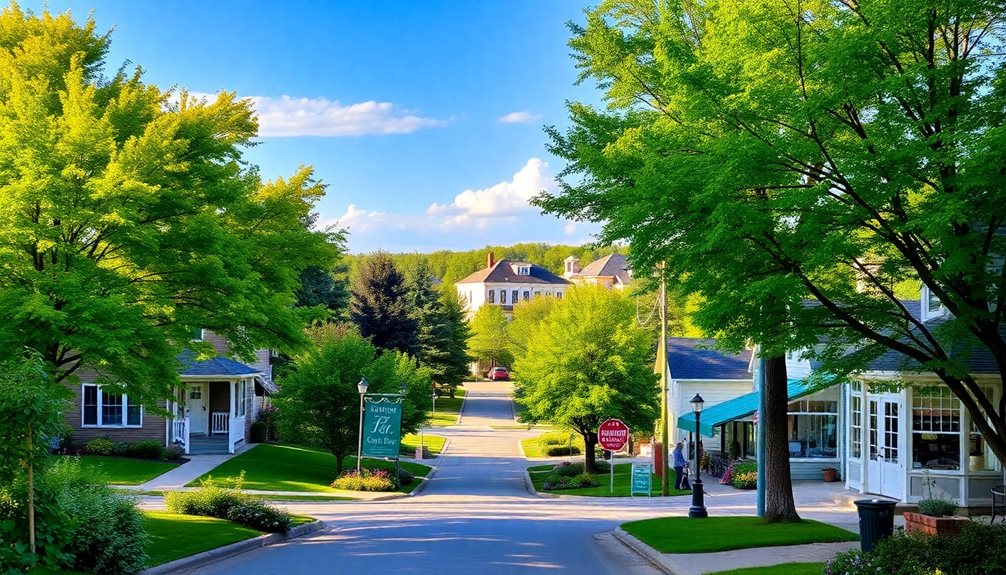
St. Louis Park, Minnesota, is a thriving suburb of Minneapolis, with a population of about 50,000 residents.
It boasts diverse neighborhoods, rich ethnic heritage, and a highly regarded educational system, featuring International Baccalaureate programs and private schools like Benilde-St. Margaret's.
The community is known for its vibrant arts scene, numerous recreational parks, and accessible walking trails.
St. Louis Park is celebrated for its vibrant arts, scenic parks, and accessible walking trails.
Residents enjoy close proximity to major urban amenities while maintaining a tranquil suburban feel.
The city features several hidden local gems that showcase its unique character and charm.
Educational Opportunities
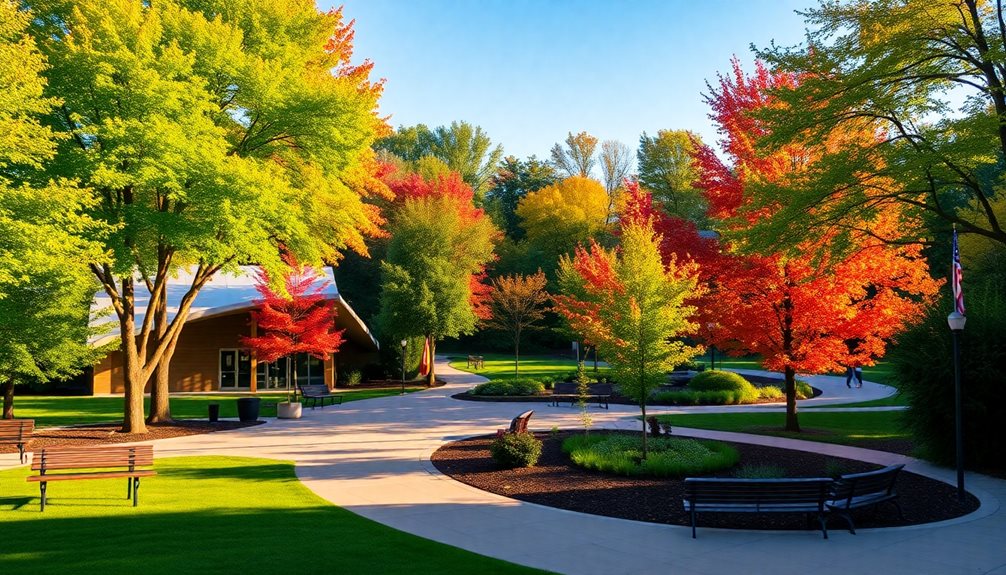
Educational opportunities in St. Louis Park, MN, are diverse and extensive. The St. Louis Park Public School District offers robust enrichment programs for K-5 students, focusing on STEAM education with 120 minutes of gifted and talented learning per week. For lifelong learning, St. Louis Park Community Education provides classes from infancy to adulthood. While St. Louis Park offers comprehensive education, nearby Medina's charming environment provides additional cultural learning experiences for area students.
| Program | Age Group | Focus |
|---|---|---|
| Preschool | 3-5 years | Early Learning |
| Youth Enrichment | K-12 | STEM, Arts |
| Adult & Senior Enrichment | 18+ | Fitness, Cooking |
| Early Childhood Family Education | 0-5 | Parent-Child Interaction |
| Project SOAR | Adults with Disabilities | Specialized Activities |
Cultural Attractions and Events
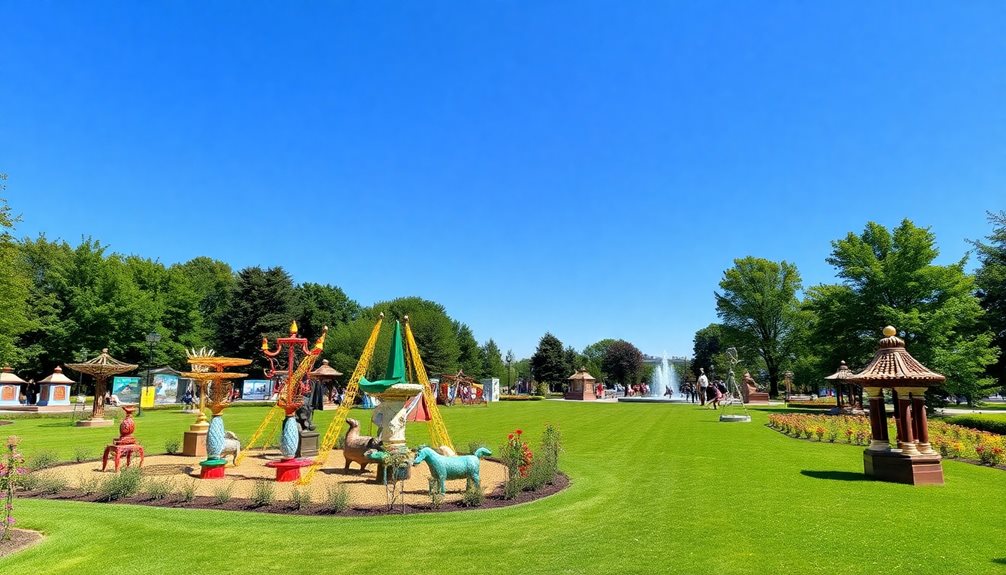
In St. Louis Park, cultural attractions and events embody freedom through diversity. The city hosts the St. Louis Park Art Fair, celebrating local art and community spirit.
Events like the MinnesoThai Street Food Festival showcase international traditions, while the Westwood Hills Nature Reserve offers a natural, serene escape.
The Twin Cities Film Festival brings a cinematic highlight, featuring independent films.
These events reflect the city's vibrant atmosphere, blending local identity with global influences, providing a rich cultural experience for residents and visitors alike.
Recreation and Leisure Activities**
Recreational opportunities in St. Louis Park offer a myriad of activities for residents and visitors alike.
The St. Louis Park Rec Center features an outdoor aquatic park with water slides and an aqua obstacle course, as well as two indoor ice arenas for public skating and hockey.
Additionally, the Recreation Outdoor Center (ROC) provides seasonal activities, including a covered ice rink and turf.
Local parks, such as Westwood Hills Nature Reserve and Twin Lakes Park, also offer outdoor spaces for leisure and nature exploration.
Other attractions include craft breweries and virtual reality experiences.
Expert Final Thoughts
St. Louis Park, Minnesota, is a vibrant community offering a rich mix of cultural, educational, and recreational opportunities. Its strong education system and diverse community foster inclusivity, while numerous parks and trails provide ample leisure activities. Public art initiatives and cultural events enhance its appeal, making St. Louis Park an attractive choice for residents seeking both tranquility and access to urban amenities near Minneapolis.
